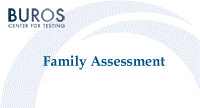Buros-Nebraska Series on Measurement and Testing
Date of this Version
1995
Document Type
Article
Citation
Family Assessment, ed. Jane Close Conoley & Elaine Buterick Werth (Lincoln, NE: Buros Institute of Mental Measurements, University of Nebraska-Lincoln, 1995).
Abstract
Assessing families suggests both interesting measurement issues and significant clinical applications. This volume is a collection of important papers to explore the topic in some depth.
Some of these papers were first given at the Buros-Nebraska Symposium on Testing and Measurement. Others have been written especially for this volume. All are outstanding examples of scholarship in this very thorny area of psychological measurement beyond the individual. We commissioned papers that examined the history of measurement with families and to cover family issues that are of particular interest to both clinicians and researchers.
The book is divided in three sections. Drs. Halverson and Carlson introduce our topics in two important chapters. Halverson provides readers with a discussion of quantitative measurement of the family from multiple perspectives. He provides a brief, but comprehensive, overview of the history of family assessment by exploring the development of techniques and instruments used for measuring various aspects of the family and interactions within the family system. Dr. Halverson identifies the major shortcoming of the evolution of family assessment as being the development of "too many measures measuring too many constructs."
Dr. Carlson explores the theoretical and practical issues in family assessment. Using family systems theory, Carlson explores the assessment process highlighting the different purposes served by clinical and research assessment procedures. Whereas structural adequacy in measurement is essential to the goal of research in verifying theory, clinicians' use of assessment to guide treatment calls for the functional or treatment utility of measures through the multifunction, sequential family assessment process that leads to decision making and evaluation. A multisystem-multimethod approach to family assessment is recommended by Dr. Carlson to guide family assessment.
The second section of the volume explores the assessment of particular family dynamics. These include aspects of marital quality, assessment of sibling relationships within families, constructs and measurement techniques associated with family health, and special challenges associated with assessing families from diverse ethnic and cultural backgrounds.
Dr. James Bray's chapter is an in-depth look at the theory and measurement of family health. He views the health of the individual from the ecological perspective of the family, both in terms of the development of individual health/ adjustment and maintenance and resolution of problems. Bray acquaints the reader with the basic assumptions of systems approaches to families and to family health. He reviews research and theory regarding healthy family functioning and issues to be addressed when studying families. Bray provides an organizational framework for studying the family that includes: status, process, affect, and organization.
Although previous chapters illustrate the challenges inherent in family assessment, Dr. Jane Close Conoley and Lorrie E. Bryant's chapter suggests that assessing ethnically diverse families further complicates the measurement process. Cultural sensitivity, the array of constructs examined in multicultural family assessment with a variety of populations, and adequacy of measurement techniques are analyzed and suggestions are offered to clinicians for the utilization of valid assessment procedures. Conoley and Bryant argue against the use of ethnic glosses and suggest that clinicians view families in the context of their specific family systems as well as from the perspective of their cultural norms. Identification of family membership and roles of family members are discussed within the context of various cultures.
Michelle Schicke's chapter is an exposition of sibling relationships as they relate to psychosocial development and family structure. The research literature on the characteristics and the quality of sibling relationships is reviewed and issues involved in the assessment of these relationships are discussed. Schicke's investigation illustrates the multiplicity of influences on anyone individual in the family system in his or her relationship with other family members. The birth of a sibling, birth order, quality of interactions among siblings, combined with other relationship variables and individual characteristics such as gender and temperament, influence and are influenced by parental involvement and response.
Included in
Educational Assessment, Evaluation, and Research Commons, Family, Life Course, and Society Commons, Quantitative, Qualitative, Comparative, and Historical Methodologies Commons



Comments
Copyright © 1995 by Buros Institute of Mental Measurements. Digital Edition copyright © 2012 Buros Center for Testing.